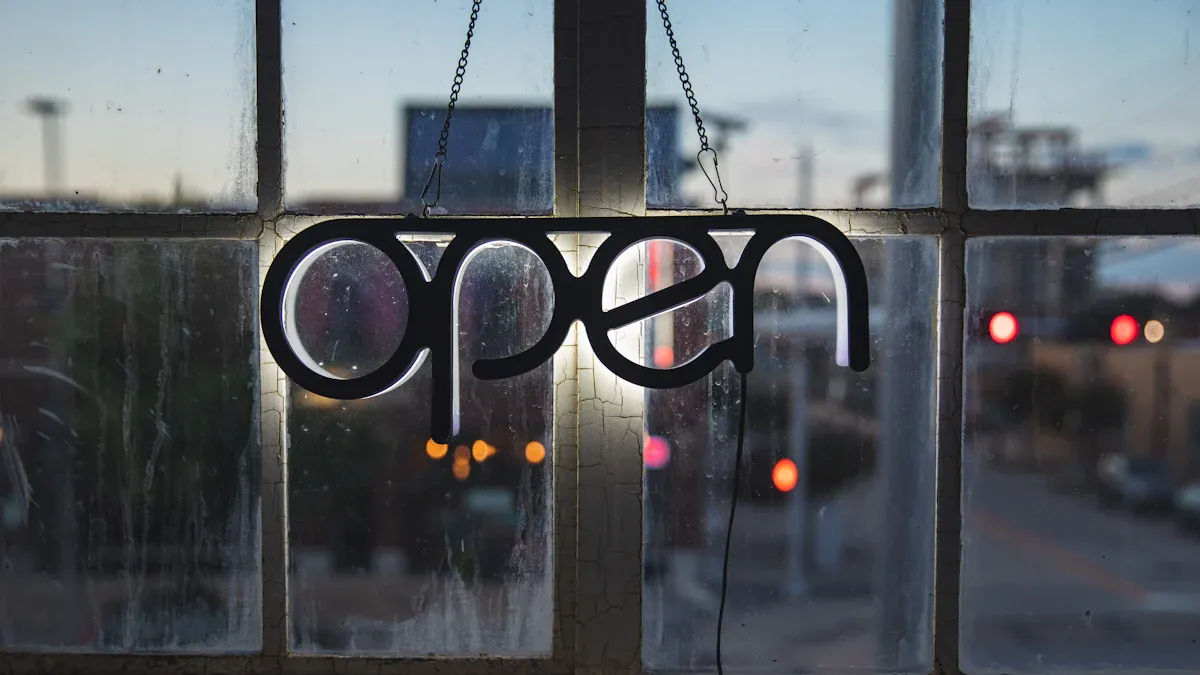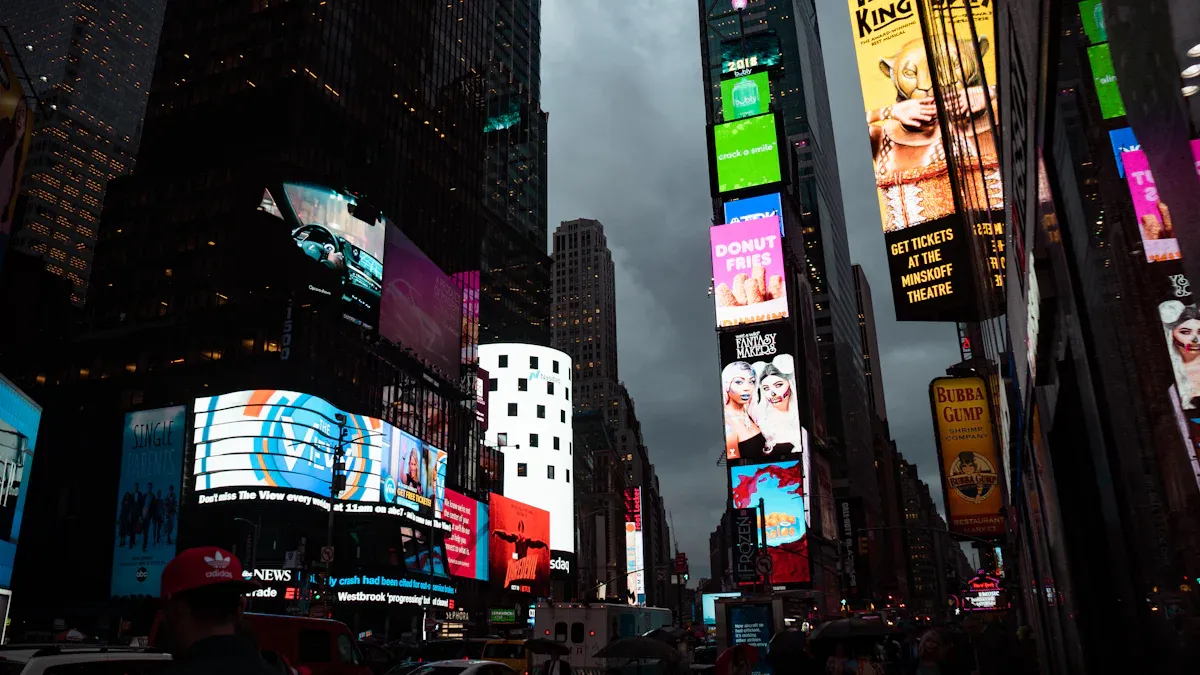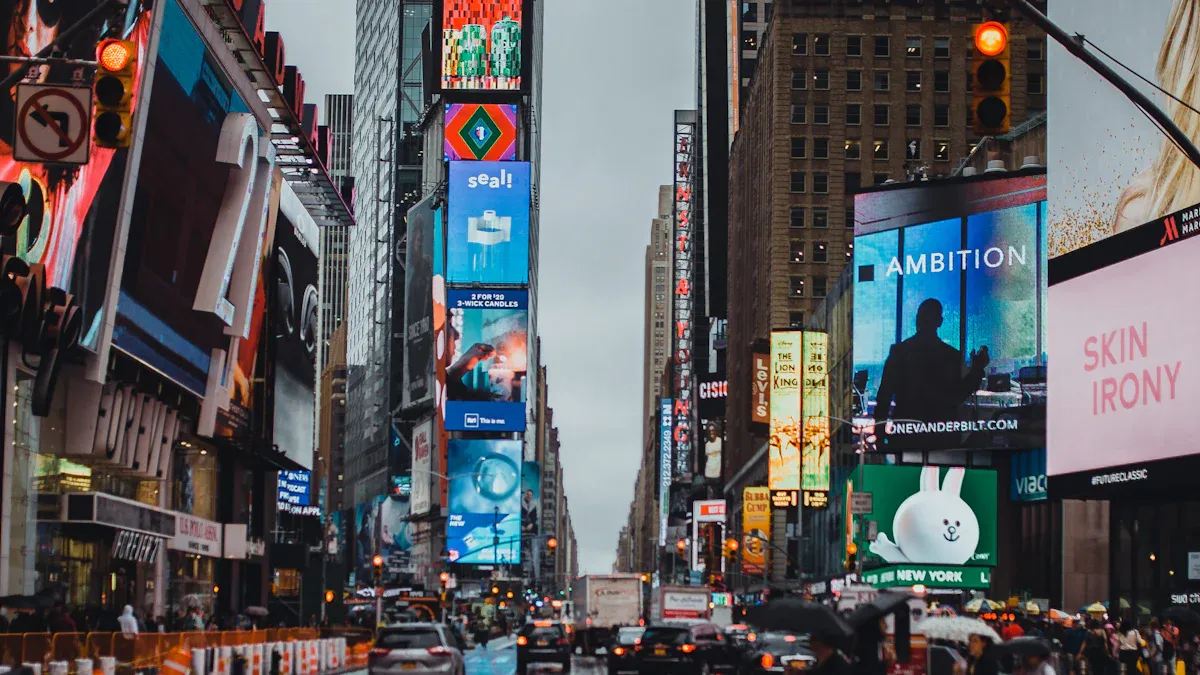Comparing Digital LED Signage Display Options: Indoor vs. Outdoor Solutions

When picking indoor or outdoor Digital LED Signage, know their differences. Indoor signs have better resolution for close-up viewing. Outdoor Digital LED Signage is made to handle weather and bright sunlight. New Digital LED Signage uses 30% less energy than older ones. Outdoor Digital LED Signage is 38% better than LCD screens in bright light. Both types are great for ads but suit different places and uses.
Key Takeaways
Indoor LED signs are clear and sharp for close-up viewing. They work well in malls and offices.
Outdoor LED signs are made to handle bad weather and sunlight. They stay visible in busy places.
Brightness is important. Indoor signs need 300-500 nits of light. Outdoor signs need over 2,500 nits to be seen in sunlight.
Saving energy is important. Newer LED signs use 30% less power. This helps the planet and saves money.
Think about repair costs. Indoor signs cost less to fix. Outdoor signs can cost $2,000 to $10,000 each year.
Durability and Weather Resistance

When picking digital LED signs, think about durability and weatherproofing. These features show how well the signs work in different places. Let’s see how indoor and outdoor LED signs compare.
Indoor Digital LED Signage
Indoor LED signs are made for places like malls and offices. They focus on looking good and working well, not being tough. Since they stay indoors, they don’t need strong materials like outdoor signs. For example, indoor signs aren’t very waterproof and don’t handle dust or heat well.
Indoor signs have high resolution and medium brightness, around 2,500 nits. This makes them great for close-up viewing with clear details. But they can’t be used outside because they can’t handle rain, wind, or sunlight.
Specification | Indoor LED Signs | Outdoor LED Signs |
|---|---|---|
Weather Resistance | Not made for bad weather | Built for all weather |
Construction Materials | No heavy-duty materials | Strong materials with silicone coating |
Brightness Levels | Medium brightness (about 2500 nits) | Very bright (up to 10,000 nits) |
Waterproofing | Low waterproofing | High waterproof, dust-proof, and leak-proof |
Resolution | High for close viewing | Lower for far viewing |
Best Outdoor LED Display Boards
Outdoor LED signs are made to handle tough weather and still work well. They are waterproof, dust-proof, and leak-proof. Strong materials and silicone coating keep them safe in rain, snow, and heat.
Outdoor signs are also super bright, up to 10,000 nits. This makes them easy to see even in sunlight. They are perfect for outdoor ads where being seen is important. For example, outdoor LED boards in places like Riyadh Season or Lusail Stadium show how they work in big, open areas. These signs survive bad weather and give viewers a great experience.
Case Study | Location | Display Type | Key Features |
|---|---|---|---|
Riyadh Season | Riyadh, Saudi Arabia | UfixII8/10, Uslim-O03, Kslim2.9 | 7,000 square meters of immersive displays |
Lusail Stadium | Doha, Qatar | E Series | 70.78-square-meter screen for replays and ads |
Ten Square | Singapore | Usurface III | Dynamic content and landmark visibility |
Outdoor LED signs are great for grabbing attention in busy areas. Whether it’s a street ad or a stadium screen, these signs are tough and bright to meet your needs.
Brightness and Readability

When picking digital LED signs, brightness is very important. It helps your message stay clear and easy to see. Both indoor and outdoor signs need the right brightness to work well. Let’s look at how brightness affects indoor and outdoor LED signs.
Best Indoor LED Digital Display Solutions
Indoor LED signs are made for places like malls and stores. These areas usually have less light, so they don’t need to be super bright. But in bright spots, like near windows, higher brightness is needed.
For most indoor spaces, 300 to 500 nits is enough. This keeps your content clear without being too bright. In brighter areas, like store windows, you may need over 1,000 nits. This keeps your sign easy to read and noticeable.
Indoor LED signs with 1,000 nits work well in most places.
For bright spots, like windows, higher brightness is better.
Lower brightness saves energy in dim areas but stays readable.
Choosing the right indoor LED sign helps your ads look great. These signs mix good brightness with sharp details, perfect for close viewing.
Outdoor Digital Signage for High Visibility
Outdoor LED signs face tough challenges like sunlight and weather. They need to be very bright and strong to work well. Brightness is key for outdoor ads to stand out in busy places.
For shaded outdoor spots, 1,500 to 2,000 nits is good. In indirect daylight, 2,000 to 2,500 nits works best. For direct sunlight, over 2,500 nits is needed. Some outdoor signs, like the XE3P model, can reach 3,500 nits for very sunny areas.
Outdoor signs with over 2,000 nits stay clear in bright light.
Signs with 3,500 nits are great for sunny streets or stadiums.
Bright outdoor signs grab attention, even from far away.
When picking outdoor signs, think about brightness and strength. This makes sure your signs last long and show clear messages.
Environment | Recommended Nits |
|---|---|
Indoor (standard lighting) | 300–500 |
Outdoor (shaded) | 1,500–2,000 |
Outdoor (indirect daylight) | 2,000–2,500 |
Outdoor (direct sunlight) | 2,500+ |
By knowing how much brightness is needed, you can pick the best LED signs. Whether for indoor shoppers or outdoor crowds, the right brightness makes your message stand out.
Resolution and Viewing Distance
Indoor Digital LED Signs for Close Viewing
Indoor LED signs are great for places where people are near them. They need high resolution to show sharp and clear images. Pixel pitch is important for how clear the picture looks. Smaller pixel pitches, like 2.5 mm or 3.9 mm, work best for close viewing. These make sure your content looks neat and grabs attention.
For example, a 2.5 mm pixel pitch with 1920 x 1280 resolution works well up close. A 3.9 mm pixel pitch with 1440 x 864 resolution also looks great indoors. These setups are perfect for stores or offices where signs need to be interactive and engaging.
Pixel Pitch (mm) | Best Resolution (pixels) | Viewing Distance (ft) |
|---|---|---|
2.5 | 1920 x 1280 | Close |
3.9 | 1440 x 864 | Close |
4.0 | 1920 x 1200 | Close |
When picking indoor LED signs, think about where they’ll be used. Smaller pixel pitches make sure your signs look clear, even in bright areas.
Outdoor LED Signs for Far Viewing
Outdoor LED signs focus on being easy to see from far away. They use bigger pixel pitches, like 10 mm, for outdoor spaces. These signs stay clear while saving energy and being bright enough for ads.
To find the best viewing distance, use the Three-foot Rule. Multiply the pixel pitch by three to get the minimum distance. For example, a 10 mm pixel pitch works best at 20 meters away. This keeps your sign readable in busy outdoor places.
Pixel Pitch (mm) | Minimum Viewing Distance (m) |
|---|---|
2 | 4 |
10 | 20 |
Outdoor signs often use bigger fonts to make reading easier. For example:
Use 20pt font for 5 feet away.
Use 100pt font for 25 feet away.
These signs are great for stadiums, highways, or public spaces. They are bright, strong, and grab attention from far away. Picking the right pixel pitch and resolution ensures your outdoor signs send clear messages that stand out.
Energy Efficiency
Saving energy is important when picking digital LED signs. Whether for indoor or outdoor use, knowing energy needs helps you choose wisely. It also supports your advertising goals and the environment.
Energy Use of Indoor Digital Signs
Indoor LED signs use less power because they aren’t super bright. They work in places like malls or offices with steady lighting. New tech, like content management systems (CMS), lets you control energy use from anywhere.
These signs have power-saving modes and brightness settings you can adjust. For example, indoor LED cabinets use 18 to 34 watts on average. At most, they use up to 100 watts. They also don’t get very hot, with heat as low as 62 BTU/h per cabinet. This makes them a smart and eco-friendly choice for close-up ads.
Specification | Value |
|---|---|
Power Use (W/Cabinet, Max.) | 100 (-RK) / 55 (-CK, -CKF) |
Power Use (W/Cabinet, Avg.) | 34 (-RK) / 18 (-CK, CKF) |
Heat Output (BTU/h/Cabinet, Max.) | 341 (-RK) / 188 (-CK, -CKF) |
Heat Output (BTU/h/Cabinet, Avg.) | 116 (-RK) / 62 (-CK, -CKF) |
Using power-saving features and setting shorter hours can cut energy use. This keeps your signs efficient and high-quality.
Energy-Saving Outdoor LED Signs
Outdoor LED signs deal with sunlight and weather, so they need special features. They save energy with auto-brightness and low-power LED chips. These keep the signs clear without wasting power.
Outdoor signs also have sleep modes to save energy when not in use. For example, they dim automatically in low light, using less power but staying readable. These features make them great for ads in busy outdoor areas.
Type of Display | Energy-Saving Features |
|---|---|
Indoor | Uses less power due to lower brightness. |
Outdoor | Has auto-brightness and sleep modes to save energy. |
When choosing outdoor signs, think about energy-saving features, strength, and brightness. This way, your signs work well and are kind to the planet.
Cost Considerations
When picking digital LED signage, knowing the costs is important. Both indoor and outdoor signs have different expenses, from buying to upkeep. Let’s break down these costs to help you decide.
Costs for Indoor Digital LED Signs
Indoor LED signs cost less than outdoor ones. They are cheaper to make because they are simpler and less bright. But, there are still a few things that affect the price:
Buying and Installing: Indoor LED signs cost $800–$5,000 per screen. The price depends on size and resolution. Pre-assembled screens are faster to install but cost 20–30% more. Modular panels are cheaper but need experts to set them up.
Energy Use: Indoor signs use less power because they aren’t super bright. This lowers running costs. But, some setups may need power upgrades, which adds to the cost.
Upkeep: Keeping indoor signs working costs $500–$1,000 a year. Good installation is key since 68% of problems happen from bad setups.
Category | Indoor Costs |
|---|---|
Schools | $1,000–$2,500 per screen |
Hospitals | $800–$2,000 per screen |
Stores | $2,500–$5,000 |
Maintenance | $500–$1,000 per year |
Spending on high-quality screens and energy-saving tech can save money later. It also keeps your signs useful for a long time.
Costs for Outdoor Digital Signs
Outdoor LED signs are built to handle tough weather, so they cost more. They are stronger and brighter, which makes them pricier to buy and maintain. Here are the main costs:
Buying the Signs: Outdoor LED signs cost $3,000–$20,000 per screen. Bigger and better screens, like those in Times Square, cost more but give great results.
Installing and Rules: Outdoor signs need licensed workers to meet safety rules. Permits and electrical work also add to the cost.
Upkeep: Outdoor signs need regular care to stay strong. Maintenance costs $2,000–$10,000 a year. Buying durable signs can lower repair costs.
Category | Outdoor Costs |
|---|---|
Schools | $5,000–$20,000 |
Hospitals | $3,000–$6,000 |
Stores | $500–$1,500 |
Maintenance | $2,000–$10,000 per year |
Outdoor signs are great for grabbing attention. But picking the wrong one can cost more in the long run. Spending on good-quality signs ensures they last and work well for your ads.
Suitability for Specific Use Cases
Advertising with Indoor Digital LED Signage
Indoor digital LED signage works well in places like stores and offices. These signs have clear images and interactive features. They are great for keeping people interested. For example, stores use them to show products, share discounts, and boost sales. Restaurants use digital menus to change prices quickly and highlight deals. This helps attract and engage customers.
Hospitals also use indoor LED signs to help patients find their way. Check-in screens make managing appointments easier. Offices use these signs to share news or plan meetings. Gyms display class times and offer virtual coaching to keep members updated and motivated.
Use Case | Description |
|---|---|
Retail Stores | Shows products, discounts, and brand stories. |
Restaurants & Cafés | Uses digital menus for pricing and deals. |
Hospitals & Healthcare | Helps with wayfinding and appointment check-ins. |
Corporate Offices | Shares news and manages meetings. |
Gyms & Fitness Centers | Displays schedules and virtual coaching. |
By matching content to the right use, indoor LED signs make ads more effective.
Advertising with Outdoor Digital Signage
Outdoor LED signage is great for catching attention in busy areas. These signs are strong and work in bad weather like rain or snow. Their brightness makes them perfect for outdoor ads. For example, a coffee shop got 30% more customers by promoting hot drinks in cold weather. Another brand, Cotswold Outdoor, saw a 41% ROI increase and 29% more revenue with weather-based ads.
Outdoor LED signs can also change content based on the weather. Ice cream brands sold 26% more by showing ads on hot days. These signs work well on highways, in stadiums, and in public spaces. They are easy to see from far away. Metrics like how many people act after seeing an ad show their success. For example, outdoor LED signs can track how many viewers buy something after seeing the ad.
Key Metrics for Outdoor LED Signage:
Impression-to-Engagement Ratio: Tracks actions after seeing the ad.
Weather-Specific Conversion Rates: Measures sales changes in different weather.
Cost Per Acquisition (CPA): Checks how much it costs to get a customer.
Outdoor LED signs are bright, tough, and flexible. They are a great choice for ads in many places.
Picking indoor or outdoor digital LED signs depends on your needs. Indoor signs are sharp and great for close viewing. They work well in offices, malls, and stores. Outdoor signs are strong and super bright. They handle bad weather and sunlight easily. Think about what you need for your ads. Look at things like distance, energy use, and upkeep costs. Choosing the right sign for your space makes a big difference. Take time to decide what works best for you.
FAQ
1. What makes indoor and outdoor digital LED signage different?
Indoor signs are made for clear, close-up views. Outdoor signs are built to be strong and bright for weather and sunlight. Pick the type based on where and how you’ll use it.
2. How do I pick the right brightness for my LED sign?
Indoor signs need 300–500 nits for normal lighting. Outdoor signs need more brightness—1,500 nits for shade and over 2,500 nits for sunlight. Match brightness to the location for clear viewing.
Tip: Auto-brightness features save energy and improve visibility.
3. Are outdoor LED signs harder to maintain than indoor ones?
Yes, outdoor signs cost more to maintain because they are weatherproof. Maintenance costs range from $2,000–$10,000 yearly. Indoor signs cost less, about $500–$1,000 per year, since they are not exposed to harsh conditions.
4. Can I use indoor LED signs outside?
No, indoor signs aren’t made for outdoor use. They can’t handle rain, dust, or sunlight. Outdoor signs are designed to survive tough weather and stay bright.
5. How do I figure out the best viewing distance for my LED sign?
Use the pixel pitch to find the best distance. Multiply the pixel pitch (in mm) by three to get the minimum distance in feet. For example, a 10 mm pixel pitch works best at 30 feet or more.
Example: A 2 mm pixel pitch is great for viewing at 6 feet.
See Also
In-Depth Analysis of Enterprise Digital Signage Solutions
Best 10 LED Digital Signage Options for Retail Spaces
Comparing Digital Signage Displays and TVs: When to Use Each
Selecting the Perfect LED Digital Sign for Your Business
Custom Digital Signage Solutions for Retail, Healthcare, and Business

